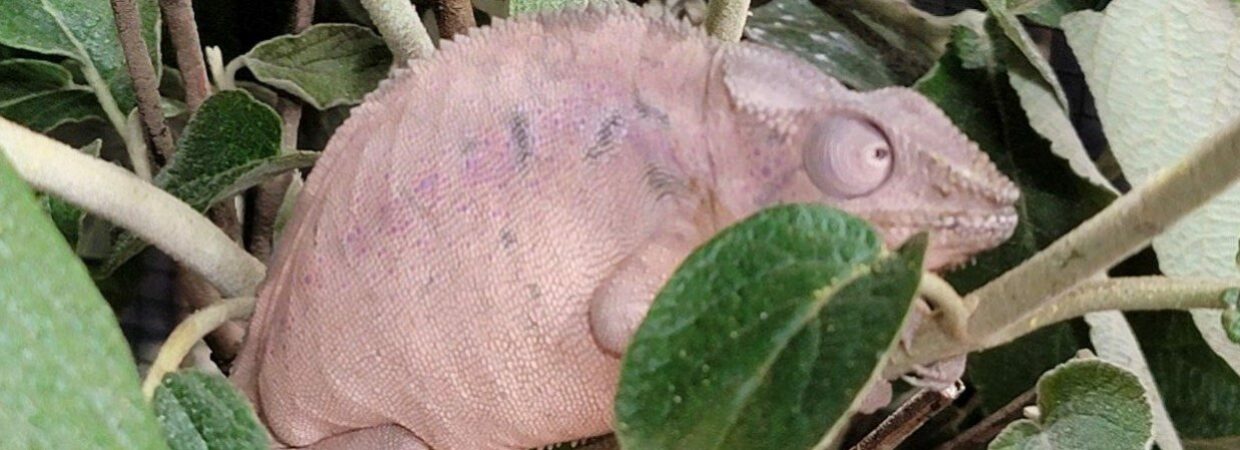

Origin: Chameleons are tree-dwelling lizards native to the Old World (Africa, Madagascar, southern Europe, and southern Asia). Their feet and tails are specialized to grasp tree branches, and they walk slowly, swaying like a leaf in the wind.
Scientific Name: (Chamaeleonidae)
Size: Chameleons are 4 inches long when they hatch and grow between 15- and 20-inches long nose to tail for adult male chameleons. Adult females are shorter at around 10 to 18 inches.
Diet: Chameleons generally eat insects such as locusts, mantids, grasshoppers, stick insects, and crickets. Some larger chameleons also eat small birds and other lizards. A few have been known to eat a bit of plant material.
Life Span: Veiled Chameleon (6-8 Years), Panther Chameleon (5-7 Years), Jackson (5-10 Years).
Lighting: Chameleons must have UVB light to survive. Lack of UVB will lead to Metabolic Bone Disease, severe deformation, and eventual death. UVB can be given through unfiltered sunlight (UVB does not penetrate glass or plastic well) or through commercially available fluorescent UVB bulbs.

Temperature: During the day, the cool area should be between 70- and 80-degrees Fahrenheit (21 to 27 Celsius), while the warm area should be between 80 and 85 F (27 to 29 C) for Jackson’s Chameleons, or 90 and 100 F (32 to 38 C) for Veiled Chameleons.
Humidity: Ideal humidity is 30-50% humidity during the day and 80-100% humidity during the night and should be monitored using a hygrometer inside the enclosure. Early morning fogging is recommended for 3-5 hours ending an hour before lights turn on.
Enclosure: Chameleons should be housed individually. Choose a well-ventilated terrarium or screened enclosure that’s at least 16 x 16 x 30 inches. Line the bottom of the habitat with reptile carpet, 2 to 3 inches of coconut fiber or reptile bark. In general, most chameleons need very large enclosures with good fresh air circulation. Because most of them are arboreal (living in plants or trees), they need large plants to climb. Some require high humidity. Many like to be occasionally misted with water, and all need a regular source of dripping water to drink.
Level of Care: Chameleons are not that hard to take care of once you have their setup correct. Once the setup is correct it’s much easier to care for them. However, they do require more attention and vigilance than most other pets to ensure that they are happy and healthy. Remember that chameleons, in general, are not good as a beginner reptile due to their complex needs and susceptibility to stress (especially while handling them) but if you are a seasoned reptile owner and are ready to take that next step the veiled chameleon might be for you.


Cost of Care: Expect to spend around $500 on initial equipment to include the cage, lighting, and enough food and supplements to last the first 10 days or so. From there, you should expect annual costs equivalent to about $100 a month or $1,200 a year.
Does a Bite Hurt: A chameleons bite is painful, however, not toxic or harmful to humans. Handling can cause chameleons to have chronic low-level stress, which leads to poor health. Chameleons have different personalities — some welcome being handled, while others prefer not to be touched. It is possible to hold a chameleon, but chameleons do not like being held and they don’t enjoy being petted either. Some can develop a tolerance for holding but they are much better suited to being left alone and observed from afar.

Misting: Chameleons need to be misted about twice a day on average, and that should be with a dripper, I would mist for about 3 minutes at least. If he’s still drinking after those two minutes, you might want to consider misting for 30 seconds longer. The cage should be misted in the morning and at night, drying out completely between misting sessions. This raises relative humidity as well as stimulates your chameleon to want to drink
How to tell if Your Chameleon is Dehydrated: Luckily, a dehydrated chameleon will display several specific physical symptoms that will tell you they are dehydrated and need urgent care. These symptoms include sagging skin, sunken eyes, yellow to orange urate, distinct lethargy, and a loss of appetite.

Breeding: To breed chameleons, you need to bring a male and female together during their breeding season, which is usually early spring after the cold period. After they mate, the female will begin pacing 10-15 days after. This is when you should move her to a nesting box for laying eggs, which will hatch 9-12 months later. If the female is not receptive, she’ll either quickly try to run away from the male, or she’ll start gaping (hissing with mouth open) towards him, or both. If she’s receptive, she’ll walk slowly, and will seemingly not pay much attention to the male’s advances. She’ll then allow mating, which takes anywhere from 5 minutes to an hour.
Safe Plants: The best live plants to include in your chameleon’s enclosure, considering both looks and safety are golden photos, yuccas, rubber trees, hibiscus, Ficus benjamina, and Ficus elastica. Some other plants you can include are the Schefflera arboricola (also known as dwarf umbrella tree) and Split Leaf Philodendron.
Veterinarian Check Up: Generally, we need to say first: A sick chameleon ALWAYS needs a reptile vet. The fact that many chameleons die despite treatment is in most cases not due to wrong treatment or an “untreatable” chameleon, but due to a presentation of a deadly sick animal to the vet when it’s far too late. Your chameleon should be given a check-up by your veterinarian every 6-12 months
Please Do Research On the Exact Chameleon Before Purchase

